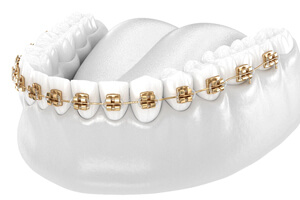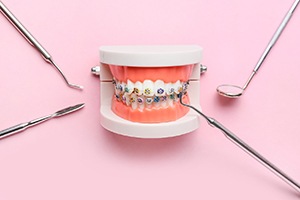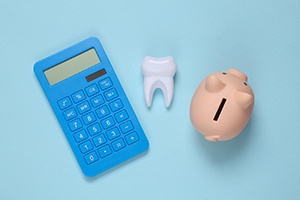
Traditional Braces – East Hartford, CT
The Tried and True Path to Straighter Teeth

If you suffer from a degree of dental misalignment, you should certainly consult with a professional dental team about straightening your teeth. Not only can orthodontic treatment enhance your facial aesthetics, but it can also provide significant oral health benefits. Modern dentistry offers a number of teeth-straightening methods, but traditional braces remain one of the most popular and effective options. Get in touch with our office today to learn more about how they may be able to help you achieve a healthier, more attractive smile.
WHY CHOOSE COMPREHENSIVE DENTAL ASSOCIATES OF CENTRAL CONNECTICUT FOR TRADITIONAL BRACES?
- On-staff orthodontist
- Friendly and caring team
- Flexible payment options
How Do Traditional Braces Work?

When you first receive braces, small metal pieces called brackets will be bonded to your teeth. A wire, called an archwire, will attach the brackets to one another. Together, the brackets and wire will apply gentle, consistent pressure to your teeth in order to move them into their proper positions. Some patients require additional orthodontic accessories, such as small rubber bands, to achieve optimum results. You will visit us periodically (every 6 – 8 weeks or so) so we can adjust the braces and monitor the movements of your teeth.
We will be able to provide you with details about your treatment journey after we have the opportunity to examine your teeth during your consultation. We will also be pleased to answer your questions about what you should eat and how you should clean your teeth throughout your time with braces.
Who Is a Candidate for Traditional Braces?

Traditional braces are appropriate for a wide range of individuals. They are useful for both children and adults, and they can correct many different orthodontic issues, from the mild to severe. Some examples of problems they can usually address include:
- Overbite
- Underbite
- Crossbite
- Crowded teeth
- Gapped teeth
- Rotated teeth
Of course, traditional braces are not ideal for everyone. If you have mild to moderate dental misalignment and would prefer a more discrete way to straighten your teeth, ask us about Invisalign® clear aligners. Our goal is to create a treatment plan that meets both your needs and your preferences.
Benefits of Traditional Braces

Some of the most outstanding benefits of traditional braces include:
- Cost-effectiveness. Traditional braces are usually one of the most affordable forms of orthodontic treatment. Here at Comprehensive Dental Associates of Central Connecticut, we frequently offer special pricing to help patients get the treatment they need.
- Predictable results. This treatment has helped millions of people achieve healthier teeth.
- Many patients appreciate that since braces are always on the teeth, there is no risk that you will accidentally forget to wear them.
- Fun colors. Braces come in many different colors. You can choose subtle hues or opt for colors that show your support for your favorite sports team.
- Modern braces are more comfortable than those of past generations. Most patients are able to adapt to them fairly quickly.
Understanding the Cost of Traditional Braces

Generally speaking, the cost of traditional braces in East Hartford is less than that of other orthodontic treatment options. However, since the exact price varies from person to person, you will have to visit us for a consultation to learn how much it will cost to straighten your teeth. Our team will also help you explore payment options, such as insurance and financing.
Factors That Affect the Cost of Traditional Braces

Some factors that influence the cost of traditional braces include:
- The complexity and severity of your dental misalignment. Complex and severe cases take more time, require more appointments, and typically use more accessories than simpler cases. Therefore, they tend to come with a higher cost.
- Your age. The teeth of adults move slower than those of younger patients. Your age might extend your treatment timeline and lead to a slightly higher overall fee.
- Your compliance with treatment guidelines. Missteps in treatment — for example, if you accidentally break your braces or fail to wear elastics as directed — can delay your final results and incur extra fees.
Professional Braces vs. DIY Braces: Which Costs More?

You may have seen hacks on social media or other platforms detailing ways you can make “DIY” braces. These methods might use items like paperclips, dental floss, and even superglue to move the teeth. While they may seem like an intriguing way to save money, extreme caution is in order.
You could end up harming your teeth and gums. It is also possible that your teeth will move in the opposite direction that they should. Ultimately, you may end up having to pay more to correct the damage from DIY methods than if you had invested in professional treatment right from the beginning.
Does Dental Insurance Cover Braces?

Dental insurance plans vary significantly in how they approach traditional braces. Some plans do not cover them at all, while others limit their coverage to patients under a certain age (usually 18 or 21). A few premium plans cover braces for adults. If yours does, your policy might pay for up to half of your treatment, up to the amount of its lifetime orthodontic maximum. For many patients, this allows them to save hundreds of dollars or more on their teeth-straightening service.
Options for Making Braces Affordable

Beyond insurance, there are a few provisions that may make it easier for you to afford braces:
- We periodically offer promotions that help patients save on orthodontic treatment. Contact us to learn if we have any current deals that you can take advantage of.
- Most patients are eligible for low-interest financing through CareCredit.
Are you ready to learn more about braces and their cost? Our team is ready to answer your questions. Get in touch today to request a consultation.
Traditional Braces FAQs

Our team is ready to help you straighten your teeth with traditional braces in East Hartford. Since this treatment requires a significant investment of time and money, however, we understand if you want more information before you commit to anything. To help you out, we have put together a list of answers to some frequently asked questions about braces. If you do not see your specific questions addressed, get in touch with us so we can personally assist you.
Am I Too Old to Get Braces?
In the eyes of many people, traditional metal braces are associated with childhood and adolescence. However, it is important to note that there is no upper age limit for this treatment. People in their 30s, 40s, and beyond have been able to benefit from it. In fact, close to one-quarter of orthodontic patients are adults!
Treatment is largely the same for both children and adults. However, adult treatment may take slightly longer. Also, while some insurance policies cover orthodontia for minors, they are less likely to do so for older patients. Our practice offers convenient payment options for adults who do not want to pay for the entirety of their braces upfront.
What Happens After You Get Your Braces Off?
Teeth have a sort of memory, which means that after your braces are removed, they may start to drift back into their original positions. To prevent this, you must wear a retainer. There are a few different types of retainers, including those that are removable and those that are fixed to the teeth. If you have a removable one, you should wear it full-time (20 – 22 hours each day) at first. Later, you may be able to wear it only at night. Eventually, you might need it for just a few nights each week.
How Long Do Traditional Braces Take?
Most cases take 1 – 3 years to complete. Your treatment timeline will depend largely on the extent of your dental misalignment; logically, more severe and complex cases take longer to correct. Other factors that can influence how long you will wear braces include:
- Your age. Bone remodeling tends to slow down with age, which means that adults’ teeth are not as quick to move as those of children.
- Compliance with treatment guidelines. Missteps and accidents like breaking your braces or forgetting to use certain accessories can delay the conclusion of your treatment.
Do Traditional Braces Hurt?
Some soreness is to be expected immediately after you receive your braces, as well as after any adjustment appointment. This happens because braces apply pressure to the teeth, which naturally can cause some discomfort. The metal brackets and wires of braces can also irritate the mouth’s soft tissues.
Here are some tips to help you cope with braces-related discomfort:
- Use orthodontic wax to cover portions of your braces that irritate you.
- Take OTC pain relievers as necessary
- Sip on cold water.
- Call your orthodontic provider if you experience any severe or unusual pain
Can I Chew Gum with Traditional Braces?
We do not recommend that you chew gum while wearing braces. It could easily get stuck on your brackets or wires. Not only is that messy, but another potential issue could arise; the gum might end up bending your arch wires, which could interfere with your treatment and delay your final results.
If you are interested in the oral health benefits of chewing sugar-free gum (some studies suggest that it can reduce the risk of cavities), it is best to wait to adopt the habit until after your orthodontic treatment. In the meantime, regular oral hygiene practices should be adequate to protect your smile.
Can You Drink Coffee with Traditional Braces?
Yes, you can still drink coffee while wearing traditional braces. It should not interfere with the effectiveness of your treatment. However, there is a big caveat to keep in mind; coffee might stain your brackets and your teeth. Some habitual coffee drinkers have even found that the coloration of their teeth is uneven after their braces are removed.
To reduce the risk of staining, try to limit your coffee consumption. It can also be helpful to drink your coffee through a straw so it has minimal contact with your teeth. Of course, keeping up with a good oral hygiene routine is also important.
Why Do My Teeth Feel Loose with Braces?
You might be worried if you notice that your teeth feel a little loose while wearing braces, but there is probably nothing to be concerned about. A bit of extra mobility in your teeth can actually mean that your treatment is working!
In order to shift teeth, braces need to apply consistent pressure to them. This stretches and loosens the ligaments holding the teeth in place, which can make the teeth feel a bit wobbly. Your teeth should stabilize once you complete your orthodontic treatment and they have had some time to become stabilized in their new positions.
Of course, you should seek professional care if you believe your teeth are too loose.
Can Traditional Braces Fix TMJ?
TMJ disorder is a condition that afflicts the jaw joints. It can cause pain and a range of other symptoms. In many cases, its root cause is a misaligned bite. When your upper and lower teeth do not work harmoniously together, that can place extra stress on your jaw joints and the surrounding tissue.
Braces can realign the teeth and help to correct a bad bite. Following orthodontic treatment, it is possible that your TMJ disorder symptoms will be greatly reduced or even disappear altogether.